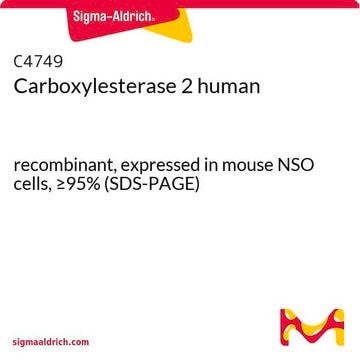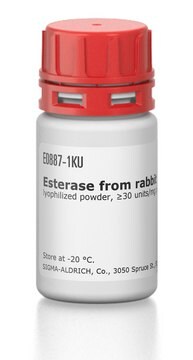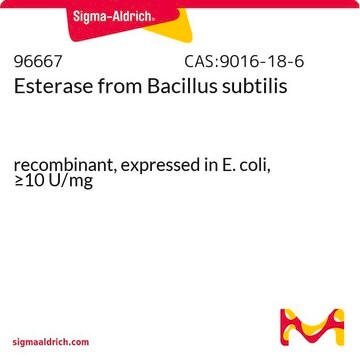E0412
Carboxylesterase 2 human
recombinant, expressed in baculovirus infected BTI insect cells
Sinónimos:
Carboxylesterase 2 human, CES2, CES2A1
About This Item
Productos recomendados
recombinant
expressed in baculovirus infected BTI insect cells
Quality Level
form
liquid
specific activity
≥500 units/mg protein
mol wt
60 kDa
weight
(0.5 ml)
shipped in
dry ice
storage temp.
−70°C
¿Está buscando productos similares? Visita Guía de comparación de productos
General description
Application
- in the in vitro enzyme-based inhibitor screening assay
- in substrate selectivity assay with emission ratiometric two-photon probe (SE1)
- as a reference standard in the enzyme assay with various 4-nitrophenyl and 1-naphthyl based substrates
Biochem/physiol Actions
Unit Definition
Storage Class
10 - Combustible liquids
wgk_germany
nwg
flash_point_f
Not applicable
flash_point_c
Not applicable
Certificados de análisis (COA)
Busque Certificados de análisis (COA) introduciendo el número de lote del producto. Los números de lote se encuentran en la etiqueta del producto después de las palabras «Lot» o «Batch»
¿Ya tiene este producto?
Encuentre la documentación para los productos que ha comprado recientemente en la Biblioteca de documentos.
Nuestro equipo de científicos tiene experiencia en todas las áreas de investigación: Ciencias de la vida, Ciencia de los materiales, Síntesis química, Cromatografía, Analítica y muchas otras.
Póngase en contacto con el Servicio técnico





